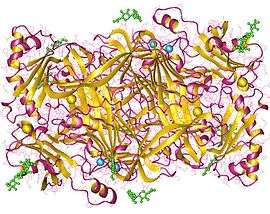Primary-amine oxidase
Primary-amine oxidase, also known as semicarbazide-sensitive amine oxidase (SSAO),[1][2] is an enzyme (EC 1.4.3.21) with the systematic name primary-amine:oxygen oxidoreductase (deaminating).[3][4][5][6][7][8][9][10][11][12] This enzyme catalyses the following chemical reaction
- RCH2NH2 + H2O + O2 RCHO + NH3 + H2O2
| Primary-amine oxidase | |||||||||
|---|---|---|---|---|---|---|---|---|---|
 Amine oxidase (semicarbazide-sensitive) dimer, Human | |||||||||
| Identifiers | |||||||||
| EC number | 1.4.3.21 | ||||||||
| Databases | |||||||||
| IntEnz | IntEnz view | ||||||||
| BRENDA | BRENDA entry | ||||||||
| ExPASy | NiceZyme view | ||||||||
| KEGG | KEGG entry | ||||||||
| MetaCyc | metabolic pathway | ||||||||
| PRIAM | profile | ||||||||
| PDB structures | RCSB PDB PDBe PDBsum | ||||||||
| |||||||||
These enzymes are copper quinoproteins (2,4,5-trihydroxyphenylalanine quinone).
Like monoamine oxidase (MAO), SSAO can deaminate short-chain primary amines, but is insensitive to MAO inhibitors. Semicarbazide inhibits the enzyme, in addition to other hydrazines, hydroxylamine and propargylamine. However, hydrazines are weak inhibitors and stronger inhibitors have been developed.
SSAO is found in the smooth muscle of blood vessels and various other tissues. The physiological function of SSAO is not well understood. Development of blood vessels, lipolysis regulation, and detoxication are suggested. It may function as a scavenger enzyme to assist MAO. However, the oxidation process generates harmful products that may be involved in causing atherosclerosis and vascular damage in diabetes. Elevation of SSAO activity is observed in atherosclerosis, diabetes mellitus, obesity, carotid plaque cases and varicosities.
Bacterial proteins containing this domain
- Tyramine oxidase (tynA) in Escherichia coli[15][16]
References
- Andrew McDonald. "Primary-amine oxidase". ExplorEnz – The Enzyme Database. International Union of Biochemistry and Molecular Biology. Retrieved 30 December 2015.
- Solé M, Unzeta M (Nov 2011). "Vascular cell lines expressing SSAO/VAP-1: a new experimental tool to study its involvement in vascular diseases". Biology of the Cell. 103 (11): 543–57. doi:10.1042/BC20110049. PMID 21819380.
- Haywood GW, Large PJ (Oct 1981). "Microbial oxidation of amines. Distribution, purification and properties of two primary-amine oxidases from the yeast Candida boidinii grown on amines as sole nitrogen source". The Biochemical Journal. 199 (1): 187–201. doi:10.1042/bj1990187. PMC 1163349. PMID 7337701.
- Tipping AJ, McPherson MJ (Jul 1995). "Cloning and molecular analysis of the pea seedling copper amine oxidase". The Journal of Biological Chemistry. 270 (28): 16939–46. doi:10.1074/jbc.270.28.16939. PMID 7622512.
- Lyles GA (Mar 1996). "Mammalian plasma and tissue-bound semicarbazide-sensitive amine oxidases: biochemical, pharmacological and toxicological aspects". The International Journal of Biochemistry & Cell Biology. 28 (3): 259–74. doi:10.1016/1357-2725(95)00130-1. PMID 8920635.
- Wilce MC, Dooley DM, Freeman HC, Guss JM, Matsunami H, McIntire WS, Ruggiero CE, Tanizawa K, Yamaguchi H (Dec 1997). "Crystal structures of the copper-containing amine oxidase from Arthrobacter globiformis in the holo and apo forms: implications for the biogenesis of topaquinone". Biochemistry. 36 (51): 16116–33. doi:10.1021/bi971797i. PMID 9405045.
- Lee Y, Sayre LM (Jul 1998). "Reaffirmation that metabolism of polyamines by bovine plasma amine oxidase occurs strictly at the primary amino termini". The Journal of Biological Chemistry. 273 (31): 19490–4. doi:10.1074/jbc.273.31.19490. PMID 9677370.
- Houen G (1999). "Mammalian Cu-containing amine oxidases (CAOs): new methods of analysis, structural relationships, and possible functions". APMIS. 107 (S96): 1–46. doi:10.1111/apm.1999.107.s96.5. PMID 10668504.
- Andrés N, Lizcano JM, Rodríguez MJ, Romera M, Unzeta M, Mahy N (Feb 2001). "Tissue activity and cellular localization of human semicarbazide-sensitive amine oxidase". The Journal of Histochemistry and Cytochemistry. 49 (2): 209–17. doi:10.1177/002215540104900208. PMID 11156689.
- Saysell CG, Tambyrajah WS, Murray JM, Wilmot CM, Phillips SE, McPherson MJ, Knowles PF (Aug 2002). "Probing the catalytic mechanism of Escherichia coli amine oxidase using mutational variants and a reversible inhibitor as a substrate analogue". The Biochemical Journal. 365 (Pt 3): 809–16. doi:10.1042/BJ20011435. PMC 1222726. PMID 11985492.
- O'Sullivan J, Unzeta M, Healy J, O'Sullivan MI, Davey G, Tipton KF (Jan 2004). "Semicarbazide-sensitive amine oxidases: enzymes with quite a lot to do". Neurotoxicology. 25 (1–2): 303–15. doi:10.1016/S0161-813X(03)00117-7. PMID 14697905.
- Airenne TT, Nymalm Y, Kidron H, Smith DJ, Pihlavisto M, Salmi M, Jalkanen S, Johnson MS, Salminen TA (Aug 2005). "Crystal structure of the human vascular adhesion protein-1: unique structural features with functional implications". Protein Science. 14 (8): 1964–74. doi:10.1110/ps.051438105. PMC 2279308. PMID 16046623.
- O'Rourke AM, Wang EY, Miller A, et al. (2008). "Anti-inflammatory effects of LJP 1586 [Z-3-fluoro-2-(4-methoxybenzyl)allylamine hydrochloride], an amine-based inhibitor of semicarbazide-sensitive amine oxidase activity". The Journal of Pharmacology and Experimental Therapeutics. 324 (2): 867–75. doi:10.1124/jpet.107.131672. PMID 17993604. S2CID 5217225.
- Wang EY, Gao H, Salter-Cid L, et al. (2006). "Design, synthesis, and biological evaluation of semicarbazide-sensitive amine oxidase (SSAO) inhibitors with anti-inflammatory activity". Journal of Medicinal Chemistry. 49 (7): 2166–73. doi:10.1021/jm050538l. PMID 16570912.
- "EC 1.4.3.21 – primary-amine oxidase and Organism(s) Escherichia coli, Escherichia coli K-12". BRENDA. Technische Universität Braunschweig. Retrieved 8 August 2019.
- Elovaara H, Huusko T, Maksimow M, Elima K, Yegutkin GG, Skurnik M, Dobrindt U, Siitonen A, McPherson MJ, Salmi M, Jalkanen S (2015). "Primary Amine Oxidase of Escherichia coli Is a Metabolic Enzyme that Can Use a Human Leukocyte Molecule as a Substrate". PLOS ONE. 10 (11): e0142367. Bibcode:2015PLoSO..1042367E. doi:10.1371/journal.pone.0142367. PMC 4640556. PMID 26556595.
External links
- Primary-amine+oxidase at the US National Library of Medicine Medical Subject Headings (MeSH)